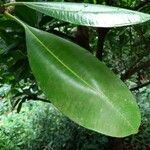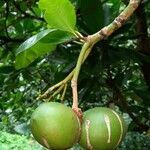Tree, 2.5-45(-60) m high. Leaves in whorls of 3 or 4 (or 5), coriaceous or papyraceous when dried; petiole 1.5-6.6 cm long, glabrous; blades usually obovate, very rarely elliptic, 6.5-36 by 3.4-18 cm, ratio 1-3, base decurrent onto petiole, margin entire, apex often rounded or acuminate, sometimes retuse, shallowly retuse or truncate; secondary veins 21-42 pairs, straight to rather arcuate ascending, not reaching the margin, joining, forming a distinct submarginal vein which is close to the margin. Inflorescence 2-17 cm long, terminal and axillary cymes, in whorls of 2-4, congested; peduncle 1-10.5 cm long. Flowers more than 30 on each inflorescence. Sepals ovate, apex rounded, thick except along the margin. Corolla white, creamy white or yellowish white, villose inside, rather dense, forming a belt of 1.5-2 mm wide just below the insertion of stamens; tube 5.3-7 mm long, tube-calyx ratio 2.5-3.5, tube-lobes ratio 0.5-0.7. Stamens inserted at 2-2.5 mm below the mouth, 0.5-0.7 of the length of the corolla tube; filaments 0.5-0.6 mm long. Pistil 2.5-3.5 mm long; ovary subglobose, apex rounded and abruptly narrowed at base of style; style 1-1.9 mm long, not split at base. Fruit composed of 2 separate mericarps; mericarps ovoid to ellipsoid, sometimes subglobose, apex apiculate, acumen strongly curled, sometimes acuminate; endocarps split into fibres penetrating the mesocarps; fibres hard and thick or rather thin and slender, forming hard thick pointed ends or not. Seeds often 1 at either placenta, rarely with a small second one.
More
A small tree up to 10 m high. The leaves occur at the ends of twigs. The leaves are clustered 3 or 4 in a circle. They are oval or rounded and narrow towards the base of the leaf. The leaf is dark green and shiny. There are many parallel side veins. The leaves are 12-28 cm long by 6-13 cm wide. The leaf stalk is 3-7 cm long. The tree has lots of milky sap or latex. The flowers are clustered in dense branched arrangements. These are white and 8-15 cm long. The fruit are oval and flattened. They hang in pairs. The nut is oval with two flat seeds inside.
A tropical plant. It grows in coastal woodlands. In the Philippines they are found only in Mindanao and Basilan. It occurs in forest along the sea shore. It can grow in salty, sandy and alkaline soils. It grows up to 200 m above sea level. It grows near the shore. The seeds are distributed by sea currents. It grows on sandy soils on atolls and high islands.
More
Coastal forest, bush or open localities, only occasionally far inland, often on limestone, at elevations up to 100 metres. Coastal vegetation on sandy and rocky shores.


